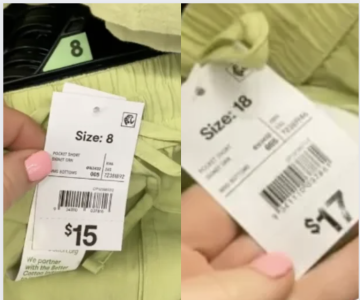Kmart dispels ‘discriminatory’ pricing rumours
Many Aussies have felt the financial impact of the pandemic, and, coupled with the relentless cost-of-living surge, everyone has been feeling the pinch.
With prices on the rise in nearly every aspect of daily life, the scrutiny of clothing costs, particularly regarding size differences, adds another layer of concern.
A Kmart pricing mix-up has reignited a long-standing discrimination debate.
A Queensland woman triggered this debate after claiming that Kmart was charging higher prices for larger-sized clothing.
On social media, she shared that in her local Kmart, a pair of green shorts in sizes 6 to 8 were all priced at $15, while the same shorts in sizes 10 and above were labelled at $17.
Kmart quickly refuted this theory, stating that all sizes of the item cost $15 at the checkout. They explained that one shipment had incorrect labels and was meant to be re-labelled in-store.
‘We don’t charge more for larger-sized items,’ they stressed, but this statement has already divided many Australians.
With over 400,000 views in under 24 hours, the video has brought forth varying opinions about whether or not this is discrimination.
‘Businesses have the right to discriminate between customers and charge different prices—for example, life insurers charge smokers more and airlines charge you more if you book at the last minute,’ said Consumer Expert Joel Gibson.
‘In this case, they could charge different prices if they wanted to, but I think it'd be commercial suicide, and they'd just lose half their customers to brands that don't discriminate.’
Among the thousands of comments received, a significant portion expressed support for businesses charging more for larger sizes.
‘I've always wondered why this isn't the case. Why should someone who is in a tiny size pay the same as someone who uses 5x the fabric?’ one person wrote.
‘If you go to Maccas and order a large milkshake, do you expect to pay the same price as a medium?’ another shared.
While some held a differing view.
‘I'll happily pay an extra $2 to shop somewhere size-inclusive,’ one person said.
‘Not you all saying this makes sense, it doesn’t. They just haven't got[ten] around to changing the prices yet on the tags,’ another commented.
‘As a big man, I’m used to paying the Fatman tax on clothing... not sure I agree with size 10+ being included in that, though,’ a third shared based on his own experience.
In 2020, Australian designer Peter Alexander was criticised for charging plus-size shoppers more than other shoppers for identical garments in standard sizes, citing ‘different patterns’ as the reason for the price disparity.
During this period, social media users publicly accused the company of engaging in discriminatory practices and blatant body-shaming.
Legal implications
Price discrimination, as defined by the Organisation for Economic Co-operation and Development (OECD), refers to the practice of charging different prices for the same or similar products or services to different customers without a valid reason.
In Australia, according to the Australian Competition and Consumer Commission (ACCC), price discrimination is not inherently illegal.
However, it can become illegal when it discriminates under specific conditions: harming competition, being deceptive or misleading, or violating specific provisions such as misuse of market power.
Video source: TikTok/@montanavincent

Members, we'd like to hear your opinions on whether it's fair to charge more for larger-sized clothing. Share your thoughts in the comments section below!
With prices on the rise in nearly every aspect of daily life, the scrutiny of clothing costs, particularly regarding size differences, adds another layer of concern.
A Kmart pricing mix-up has reignited a long-standing discrimination debate.
A Queensland woman triggered this debate after claiming that Kmart was charging higher prices for larger-sized clothing.
On social media, she shared that in her local Kmart, a pair of green shorts in sizes 6 to 8 were all priced at $15, while the same shorts in sizes 10 and above were labelled at $17.
Kmart quickly refuted this theory, stating that all sizes of the item cost $15 at the checkout. They explained that one shipment had incorrect labels and was meant to be re-labelled in-store.
‘We don’t charge more for larger-sized items,’ they stressed, but this statement has already divided many Australians.
With over 400,000 views in under 24 hours, the video has brought forth varying opinions about whether or not this is discrimination.
‘Businesses have the right to discriminate between customers and charge different prices—for example, life insurers charge smokers more and airlines charge you more if you book at the last minute,’ said Consumer Expert Joel Gibson.
‘In this case, they could charge different prices if they wanted to, but I think it'd be commercial suicide, and they'd just lose half their customers to brands that don't discriminate.’
Among the thousands of comments received, a significant portion expressed support for businesses charging more for larger sizes.
‘I've always wondered why this isn't the case. Why should someone who is in a tiny size pay the same as someone who uses 5x the fabric?’ one person wrote.
‘If you go to Maccas and order a large milkshake, do you expect to pay the same price as a medium?’ another shared.
While some held a differing view.
‘I'll happily pay an extra $2 to shop somewhere size-inclusive,’ one person said.
‘Not you all saying this makes sense, it doesn’t. They just haven't got[ten] around to changing the prices yet on the tags,’ another commented.
‘As a big man, I’m used to paying the Fatman tax on clothing... not sure I agree with size 10+ being included in that, though,’ a third shared based on his own experience.
In 2020, Australian designer Peter Alexander was criticised for charging plus-size shoppers more than other shoppers for identical garments in standard sizes, citing ‘different patterns’ as the reason for the price disparity.
During this period, social media users publicly accused the company of engaging in discriminatory practices and blatant body-shaming.
Legal implications
Price discrimination, as defined by the Organisation for Economic Co-operation and Development (OECD), refers to the practice of charging different prices for the same or similar products or services to different customers without a valid reason.
In Australia, according to the Australian Competition and Consumer Commission (ACCC), price discrimination is not inherently illegal.
However, it can become illegal when it discriminates under specific conditions: harming competition, being deceptive or misleading, or violating specific provisions such as misuse of market power.
Video source: TikTok/@montanavincent
Key Takeaways
- A Queensland woman sparked a discussion about discrimination after mistakenly believing that Kmart was charging more for larger-sized clothing.
- Kmart refuted the woman’s claim, stating that an incorrect label on one shipment was the cause of the confusion and insisted they don’t charge more for larger sizes.
- The issue opened a debate on social media about whether higher pricing for larger sizes is considered discriminatory or justifiable due to more materials used.
- This carries on from a similar controversy in 2020 when Australian designer Peter Alexander was criticised for charging plus-size customers more for identical garments.









